Company
The history of the LUXMAN audio brand began in 1925, at the birth of radio broadcasting.
LUXMAN has paid particular attention to the world of audio and has gained high reputation as a quality brand of high-end audio products both domestically and internationally.
People tend to open their mind to natural things and react negatively to the unnatural. Natural sound, without coloration, develops an intimacy between the music and the listener.
Naturally and purely reproduced music resonates with the listener’s imagination. LUXMAN reflects this effect in our product development. Music that features a performer's true passion and which a recording engineer has worked on precisely benefits from the fine nuances in sound which LUXMAN aims to reproduce, conveying the sprit of the artist and the enthusiasm of the performance.
We strive to bring to the listener the experience of unlimited, pure music.
Composers, performers and recording engineers have poured their true feelings into our favorite pieces of music. LUXMAN would be satisfied if the listener could experience those same passions through our products.
LUXMAN has celebrated its 90th anniversary and hopes to discover new excitement through wonderful music and to continue to share that pleasure with everyone.
| NAME | LUXMAN CORPORATION |
|---|---|
| ADDRESS | 1-3-1,SHINYOKOHAMA, KOUHOKU-KU YOKOHAMA-SHI KANAGAWA 222-0033 JAPAN |
| HOMEPAGE | http://www.luxman.com/ |
| PRESIDENT | TATSUYA SUEYOSHI |
History
LUXMAN started its business in 1925, the year when the radio broadcasting started in Japan. The company called Kinsuido, a picture frame company in Osaka, made a radio department, which later became LUX. Kinsuido was the first company to display and sell radio receiving equipments at the stores. A lot of people stopped to listen to the beauty of the sound. This was the very beginning of LUXMAN’s long history of tonal quality pursuit.
1925

Kinsuido (1925)
Kinsuido received a lot of information from overseas through imports of the pictures and frames. LUX founder who was the 2nd President of Kinsuido was keen on the technical information of radio and he experimented and researched radio and audio.

Kinsuido radio book
Kinsuido radio book with its catch phrase “Reading once makes you the radio expert” was the Japan –first radio manual book published by Kinsuido. It was at first self-published but later became the best seller until the 14th edition at the end. This book is known for its influence on audio engineers nowadays.
1928

LUX-1730 (LEFT) & LUX-735 (RIGHT)
LUX-735 was a hi-fi radio sold together with a magnetic-horn speaker.
1952
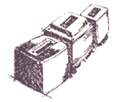
OY type output transformer
Since the beginning, Kinsuido radio department tried to have better technology to produce excellent radio/radio parts than overseas’. LUX succeeded to develop high quality parts such as OY type output transformers.
1958

Vacuum tube amplifier MA-7A
Stereo records of 45/45 launched and the main audio source became the records replaced from radio. This year LUX launched MA-7A, a hi-fi power amp by full assemble after the world war. This featured world patented original technology cross-over NFB circuit.
1961

Vacuum tube integrated amp SQ-5A
The SQ-5A was a masterpiece of it's era, which gained popularity due to the unique look of the level meter located in the middle of the front panel. This design, combined with it's high-quality sound, became a huge hit. This model was already equipped with the LUX original tone control circuit, which can be found in our latest models.
1962

Vacuum tube integrated amp SQ-65
The SQ-65 was equipped with our patent motion-feedback technology. This circuit controlled feedback to the amplifier according to the movement of the speaker's paper cone.

Germanium transistor phono amp PZ-11
Phono equalizer amplifier PZ - 11 using germanium transistor for the first time in Japan. Small and slim design also gained popularity.
1964
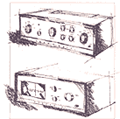
SQ-38D and WZ-30
The SQ-38, which was born as vacuum tube integrated amp in a wooden cabinet with aluminium front panel, was later developed as the SQ-38D, SQ-38F and SQ-38FD models and the 70’s anniversary model, the SQ-38S. This was a popular series and you could find them everywhere, such as at many Jazz cafés back then, being a staple of the quality hi-fi amp market.
1966

OTL vacuum tube amp MQ-36
The MQ-36 was designed without an output transformer, referred to as an OTL (Output Transformer-Less) amp. It became a popular model with a unique tasteful sound quality.
1968

Integrated amp SQ-507
The SQ-505 and the SQ-507 are the original designs which have been developed into our current 500 series. The essence of that design and the sound quality are captured in our L-507 and L-509f models.
1971-80

LUX kit brand logo
DIY amps were popular at this time and LUX founded the “LUX Kit” company, offering 70 products, including vacuum tube amps, transistor amps, turntables and other units. The brand resonated well with the audio enthusiast market.
1972

L&G brand logo and product image
The “L&G” brand was established in order to realize new proposals for audio product designs as lifestyle products. Our audio systems incorporating glamorous design and orange and white styling were popular. We gained support from those users who were always ahead current fashion.
1975
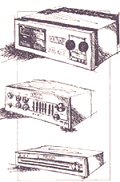
From top to bottom, M-6000 Stereo amp , C-1000 Pre-amp, T-110 AM/FM tuner
LUX celebrated its 50th anniversary and became very proactive in the overseas market. The M-6000 high power amplifier was developed to break into the hi-end market, delivering an output of 300 Watts per channel. The power and the sound quality received great reviews from overseas.
1977

Laboratory reference series
We launched a new audio system, the "Laboratory Reference Series" that takes component styles from various functional units, such as developing the world's first DC amplifier configuration. We also utilized the latest audio technologies such as synthesized tuners and high-performance equalizer circuits.
1980

PD-300 featuring the Vacuum disc stabilizer
Our vacuum stabilizer system made the surface of an analog vinyl record stick to turntable with no air gap in between. It was an epoch-making mechanism, avoiding the influence on the sound quality caused by warped records.
1982
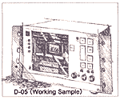
Cassette deck equipped with open reel cassette mechanism
LUXMAN developed a new transport mechanism, pulling the tape from the cassette into the reading system. This technology attracted attention as its sound quality was comparable to that of open reel tape.
1987
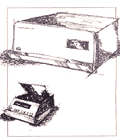
DA-07 (Top) featuring fluency DAC and CD transport DP-07
Developed a fluency DAC applying function complementation theory by Professor Toraichi of University of Tsukuba which adopted the fluency DAC. Techniques for regenerating bands other than audible bands that are not recorded on CD by function interpolation have expanded the possibilities for CD audio sources. This technology is also inherited to the current digital universal player.
1990

D-500X CD player featuring Phillips CDM-3 mechanism
We developed a top loading CD player which eliminated the certain unstable moving parts. Many audio fans still enjoy listening to the D-500X, which features the highly regarded Philips CDM-3 mechanism and excellent double crown IC chip.
1995

70th anniversary vacuum tube integrated amp SQ-38s
Our 70th Anniversary Commemorative model. With a quartet EL34 output tubes in push-pull configuration and Williamson circuitry, we poured all of our knowhow into this model to truly polish the audio quality.
1996
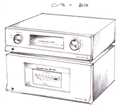
Regarded as the flagship model for ten years, C-10 and B-10
We applied a new design for this flagship system, with a Champagne gold finished symmetrical exterior and rose to the challenge of new technologies, such as the quadruple super ultimate attenuator, which spans a range of 456 fixed high precision resistors. This was adopted for C-10 and was popular amongst many audiophiles.
1999

World's first ODNF incorporated into the CM-2100 power amp for in-car audio
After many years of development, a new feedback circuit was born and applied to power amplifiers for in-car audio. Everyone was surprised, as this product brought the same quality values as home audio to the car industry. This model became a reference model for many car dealerships and car audio magazines.
2001

Hi-end universal player DU-10
The era-defining DU-10, Luxman's first offering to the high-end universal audio player market, boldly challenging the wide open field of new music formats such as SACD and DVD audio with high audio quality.
2003

LUXMAN's first fully-fledged multichannel system CU-80 & MU-80.
A motivational audio system that responds to the desire of music fans who want to enjoy not only surround sound as a home theatre playback, but also explore the uncompressed, high quality, multi-channel reproduction of SACD and DVD audio. Numerous ingenious channel settings gained a lot of attention.
2004

Vacuum tube amp CL-88 and MQ-88 with creative cutting edge design
After an 11 year hiatus since 1993, the CL-38 and MA-88 represent a return to vacuum tube separate amplifier development. These are rare examples, where the original design of conventional vacuum tube amplifiers were reconfigured and innovative proposals from the designer were adopted and mass produced.
2006

80th anniversary flagship models, the C-1000f & B-1000f
As flagship models to be renewed every ten years, this special series allowed for unprecedented investment and attention to production. Such was the confidence in the quality of these models, that the development manager decided to obtain a full set for his home.